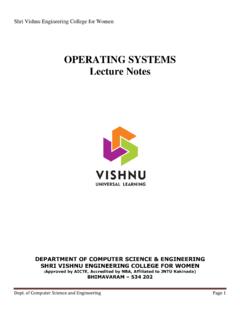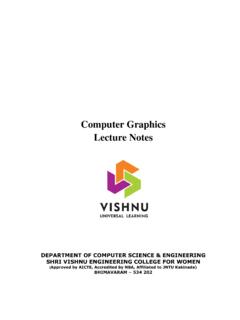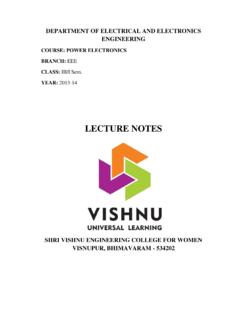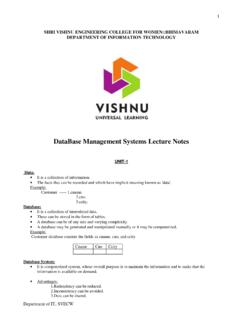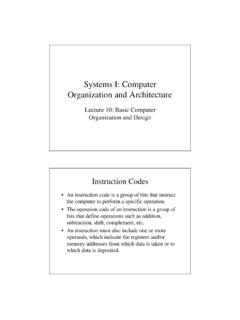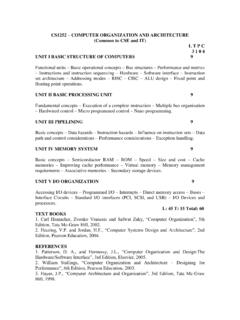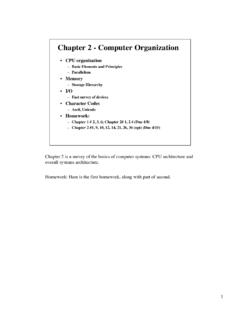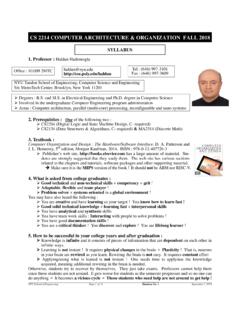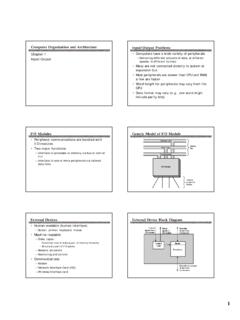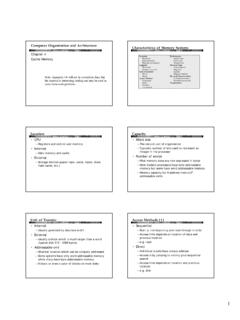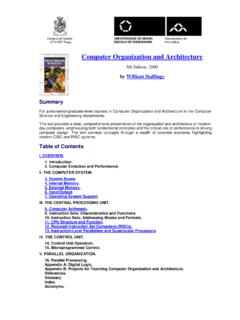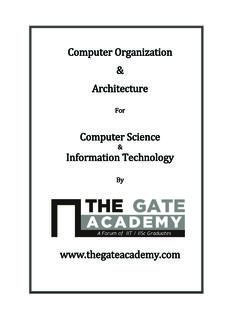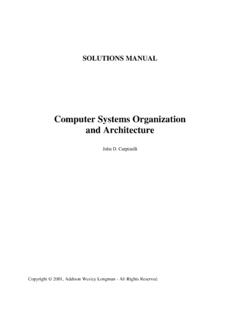Transcription of SHRI VISHNU ENGINEERING COLLEGE FOR …
1 SHRI VISHNU ENGINEERING COLLEGE FOR WOMEN::BHIMAVARAM DEPARTMENT OF INFORMATION TECHNOLOGY computer organization and architecture Lecture Notes UNIT-1 DEPARTMENT OF INFORMATION TECHNOLOGY::SVECW Page 1 UNIT-1 A BRIEF HISTORY OF COMPUERS: We begin our study of computers with a brief history. First Generation: Vacuum Tubes ENIAC The ENIAC (Electronic Numerical Integrator And computer ), designed and constructed at the University of Pennsylvania, was the world s first general-purpose electronic digital computer . The project was a response to needs during World War II. John Mauchly, a professor of electrical ENGINEERING at the University of Pennsylvania, and John Eckert, one of his graduate students, proposed to build a general-purpose computer using vacuum tubes for the BRL s application.
2 In 1943, the Army accepted this proposal, and work began on the ENIAC. The resulting machine was enormous, weighing 30 tons, occupying 1500 square feet of floor space, and containing more than 18,000 vacuum tubes. When operating, it consumed 140 kilowatts of power. It was also substantially faster than any electromechanical computer , capable of 5000 additions per second. The ENIAC was completed in 1946, too late to be used in the war effort. The use of the ENIAC for a purpose other than that for which it was built demonstrated its general-purpose nature. The ENIAC continued to operate under BRL management until 1955, when it was disassembled. THE VON NEUMANN MACHINE The task of entering and altering programs for the ENIAC was extremely tedious.
3 The programming process can be easy if the program could be represented in a form suitable for storing in memory alongside the data. Then, a computer could get its instructions by reading them from memory, and a program could be set or altered by setting the values of a portion of memory. This idea is known as the stored-program concept. The first publication of the idea was in a 1945 proposal by von Neumann for a new computer , the EDVAC (Electronic Discrete Variable computer ). In 1946, von Neumann and his colleagues began the design of a new stored-program computer , referred to as the IAS computer , at the Princeton Institute for Advanced Studies.
4 The IAS computer ,although not completed until 1952,is the prototype of all subsequent general-purpose computers. Figure Structure of IAS computer UNIT-1 DEPARTMENT OF INFORMATION TECHNOLOGY::SVECW Page 2 Figure shows the general structure of the IAS computer ). It consists of A main memory, which stores both data and instruction An arithmetic and logic unit (ALU) capable of operating on binary data A control unit, which interprets the instructions in memory and causes them to be executed Input and output (I/O) equipment operated by the control unit This structure was outlined in von Neumann s earlier proposal, which is worth quoting at this point: First: Because the device is primarily a computer , it will have to perform the elementary operations of arithmetic most frequently.
5 At any rate a central arithmetical part of the device will probably have to exist and this constitutes the first specific part: CA. Second: The logical control of the device, that is, the proper sequencing of its operations, can be most efficiently carried out by a central control organ. By the central control and the organs which perform it form the second specific part: CC Third: Any device which is to carry out long and complicated sequences of operations (specifically of calculations) must have a considerable memory .. At any rate, the total memory constitutes the third specific part of the device: M. Fourth: The device must have organs to transfer.
6 Information from R into its specific parts C and M. These organs form its input, the fourth specific part: I Fifth: The device must have organs to transfer .. from its specific parts C and M into R. These organs form its output, the fifth specific part: O. The control unit operates the IAS by fetching instructions from memory and executing them one at a time. A more detailed structure diagram is shown in Figure This figure reveals that both the control unit and the ALU contain storage locations, called registers, defined as follows: Memory buffer register (MBR): Contains a word to be stored in memory or sent to the I/O unit, or is used to receive a word from memory or from the I/O unit.
7 Memory address register (MAR): Specifies the address in memory of the word to be written from or read into the MBR. Instruction register (IR): Contains the 8-bit opcode instruction being executed. Instruction buffer register (IBR): Employed to hold temporarily the right-hand instruction from a word in memory. Program counter (PC): Contains the address of the next instruction-pair to be fetched from memory. Accumulator (AC) and multiplier quotient (MQ): Employed to hold temporarily operands and results of ALU operations. UNIT-1 DEPARTMENT OF INFORMATION TECHNOLOGY::SVECW Page 3 Figure Expanded Structure of IAS computer COMMERCIAL COMPUTERS The 1950s saw the birth of the computer industry with two companies, Sperry and IBM, dominating the marketplace.
8 In 1947, Eckert and Mauchly formed the Eckert-Mauchly computer Corporation to manufacture computers commercially. Their first successful machine was the UNIVAC I (Universal Automatic computer ), which was commissioned by the Bureau of the Census for the 1950 Eckert-Mauchly computer Corporation became part of the UNIVAC division of Sperry-Rand Corporation, which went on to build a series of successor machines. The UNIVAC I was the first successful commercial computer . It was intended for both scientific and commercial applications. The UNIVAC II, which had greater memory capacity and higher performance than the UNIVAC I, was delivered in the late 1950s and illustrates several trends that have remained characteristic of the computer industry.
9 The UNIVAC division also began development of the 1100 series of computers, which was to be its major source of revenue. This series illustrates a distinction that existed at one time. The first model, the UNIVAC 1103, and its successors for many years were primarily intended for scientific applications, involving long and complex calculations. UNIT-1 DEPARTMENT OF INFORMATION TECHNOLOGY::SVECW Page 4 The Second Generation: Transistors The first major change in the electronic computer came with the replacement of the vacuum tube by the transistor. The transistor is smaller, cheaper, and dissipates less heat than a vacuum tube but can be used in the same way as a vacuum tube to construct computers.
10 Unlike the vacuum tube, which requires wires, metal plates, a glass capsule, and a vacuum, the transistor is a solid-state device, made from silicon. The transistor was invented at Bell Labs in 1947 and by the 1950s had launched an electronic revolution. It was not until the late 1950s, however, that fully transistorized computers were commercially available. The use of the transistor defines the second generation of computers. It has become widely accepted to classify computers into generations based on the fundamental hardware technology employed (Table ). Table computer Generations THE IBM 7094 From the introduction of the 700 series in 1952 to the introduction of the last member of the 7000 series in 1964, this IBM product line underwent an evolution that is typical of computer products.

